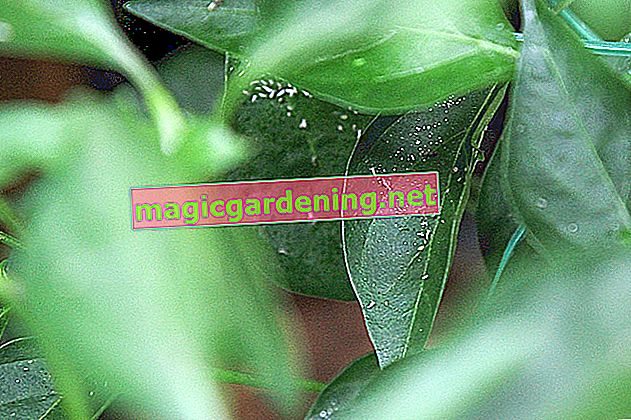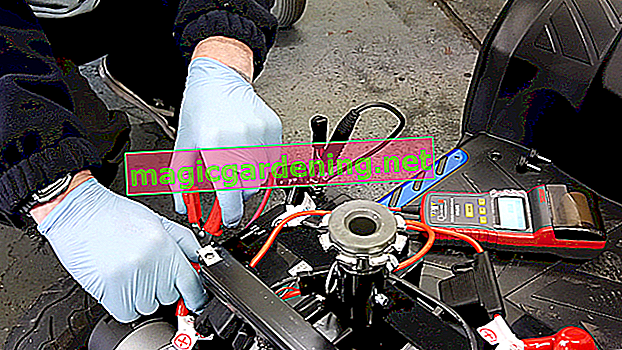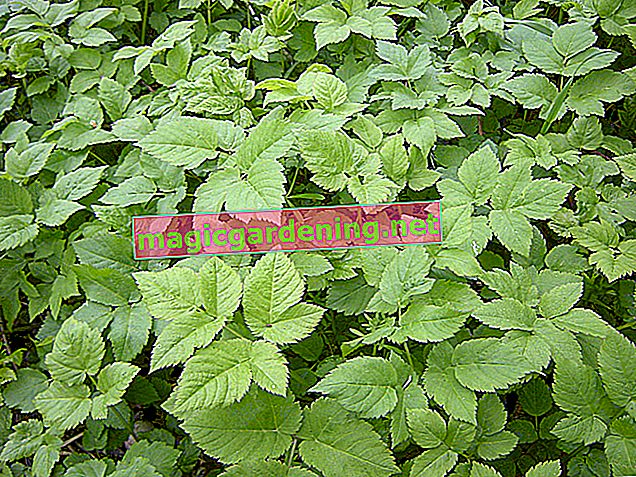
the essentials in brief
- Dormouse droppings are 1-2 cm long, bean-shaped dark brown to black. Feces and urine are odorless.
- The appearance of dormouse excrement which is characterized by an uneven, flaky surface.
- Dormouse feces are not seriously dangerous, but they do pose a hygiene risk for food and household.
Identify dormouse droppings - distinguishing features
Dormouse droppings can be recognized by their appearance. In particular, size, color and shape provide important information as to whether it is the remains of one or more sleeping mice. Last doubts remove further clues such as the surface quality of the excrement or the place where it was found. The following table summarizes the identifying features you can use to determine dormouse feces:
also read
- Dormouse - Myth and Truth
- What ants nest in the house - determination and help
- Fungi in the lawn as a nuisance - prevention and elimination
| Appearance | Locations | Other features | |
|---|---|---|---|
| size | 1-2 cm long | Attic | odorless |
| colour | dark brown to black | Roller shutter box | isolated filing |
| shape | oblong-bean-shaped | nesting box | |
| surface | uneven, scaly | Tree cave | |
| Garden shed niche |
A motto with this appearance is usually the only clue you get to see a dormouse. The funny gray fur animals are a maximum of 30 centimeters tall, active at night and very shy. Their preferred habitat are deciduous forests because beechnuts, seeds and nuts are their favorite food and they prefer to live in tree hollows. The depressing housing shortage forces the cute sleep mice to look around houses and barns for a place to stay. For this reason, faeces with the appearance explained can more and more often be dormouse solution.
Digression
Dormouse - record breaking sleepyheads

With an epic long hibernation, dorms beat a lack of food and cold. Dormice can retreat into a cozy cave for up to nine months, which is hardly bigger than the sleepyheads themselves. From late summer onwards, preparations for the record-breaking break are in full swing. Everything that makes you fat is fed. Preferably calorie bombs like beechnuts and nuts. At the same time, each dormouse digs a hole up to 100 centimeters deep and softly cushions it. With twice its body weight, the dormouse moves into winter quarters in mid-September and curls up in a spherical shape. Until early summer, the body functions run on the back burner with 3 to 5 degrees body temperature and 5 heartbeats per minute.
Differences to marten droppings and rat droppings
Fortunately, dormice are not house trained, because the nocturnal disturbances can also be other intruders, such as stone marten. Excrement is one of the few indications for an unequivocal identification and the resulting measures. Anything found in the house is worrying, because in the worst case it is dangerous rat droppings. So that you can rule out the presence of martens and rats in the house, please read the following detailed descriptions of marten droppings and rat droppings with notes on the differences to dormouse droppings:

Marten droppings
Martens are nocturnal, shy and just as good climbers as dormice. Because suitable hiding places are in short supply in meticulously tidy gardens, martens also like to move into buildings and make themselves unpopular with the human residents with nocturnal noise. In contrast to the sleeping mice, stone martens with a head-torso length of 50 centimeters are significantly larger. This fact is reflected in the size of the faeces as an important distinguishing feature. These properties distinguish marten droppings:
- Size : 8-10 cm long, 1-2 cm thick
- Color : light to medium brown or dark gray
- Shape : sausage-like, twisted tip
- Surface : crumbly, visible food remains
In contrast to dormouse droppings, marten droppings give off a repellent odor. Furthermore, stone marten excrement preferentially in the same place, which can be recognized by so-called latrines. In contrast, dormice drop their excrement where they are.
Rat droppings

The unsavory task of determining faeces finds in the house is primarily intended to rule out rat infestation. Rats are feared pests and can transmit more than 100 diseases. Where the horrors nestle, a rat plague threatens within a short time as a result of an explosive increase. For this reason, you should be familiar with the following distinguishing features of rat faeces:
- Size : 0.5-2 cm long, 0.5-1 cm thick
- Color : dark brown to black
- Shape : banana-shaped
- Surface : smooth, shiny, soft
If an acrid smell of ammonia spreads in the house, there is little doubt that you are dealing with dangerous rats and not harmless dormice.
Is dormouse droppings dangerous?
The shy, peace-loving sleeping mice pose no danger to humans. Unfortunately, this does not apply to their legacies. Dormouse droppings in the house are primarily a hygienic risk for food. The experts at the Federal Environment Agency explicitly draw attention to this. When the rodents dash through the house at night in search of treats, they drop their droppings everywhere. The contamination of food supplies cannot therefore be ruled out.
Tips
Step seals reveal the presence of the dormouse in the attic. Sprinkle a thin layer of flour on the bottom. The nocturnal poltergeists are sure to tap into it. The track can be recognized by the 10-15 mm long and 10 mm wide forefoot. The rear foot is twice as long at 20-35 mm. Round soles and toes pointing forward are characteristic of the footprints of sleeping mice.
Correctly removing dormouse droppings - tips

Removing rodent droppings requires special precautions. It is not only allergy sufferers who should avoid raising dust that is inhaled. The Robert Koch Institute draws attention to this and recommends the following procedure. How to properly remove dormouse droppings:
material
- rubber gloves
- Respirator
- broom
- Hand brush, shovel
- Buckets, scrubbers, pickups
- All purpose cleaner
- optional vinegar, vinegar essence
- Garbage bag
method
Before starting cleaning work, please open the windows and ventilate the room for at least 30 minutes. Then tilt all windows without creating a draft. How to proceed step by step:
- Put on rubber gloves and a respirator
- Sweep up the droppings with a broom
- Collect excrement with a hand brush and shovel and throw it into the garbage bag
- Fill the bucket with hot water and all-purpose cleaner
- Wipe the floor, let it dry and clean again
An effective prevention against re-contamination from dormouse droppings is vinegar. Moisten the clean floor with vinegar or vinegar essence. Sleeping mice can't stand the intense smell and will avoid the area in the future. You can achieve a similar deterrent effect with all kinds of essential oils. Frankincense is also certified to be effective in driving dormice gently and emphatically out of the house.
Offer alternative accommodation
Nobody has to tolerate dormouse droppings in the house. Responsible homeowners do not stop at excrement and eviction measures. For shy sleepy mice, the attic or roller shutter box are only a stopgap solution because there is no accommodation in the garden. For this reason, natural hobby gardeners offer evicted dormice a suitable alternative accommodation outside. As the experts from the Naturschutzbund Deutschland (NABU) recommend, sleeping mice enthusiastically accept uninhabited nesting boxes as daytime accommodation.
frequently asked Questions
What does dormouse excrement look like?
Dormice leave 1 to 2 cm small, brown-black, bean-shaped droppings. As a rule, the excrement particles are scattered or area-wide on the ground and do not form piles. An important distinguishing feature from the excrement of other rodents is that dormice feces and urine do not give off any noteworthy odor.
Is there any way to tell the difference between dormouse droppings and mouse droppings?
In fact, the appearance does not give a solid indication of whether it is dormouse or mouse feces. Size, color and shape look very similar. The minimal size difference is useless as an indication, because young dormice leave behind an equally large solution with adult mice. The only distinguishing feature is the smell. Dormouse droppings are odorless. Mouse droppings, on the other hand, spread a penetrating, intense urine smell.
We found dried dormouse droppings in the attic. How can we determine whether the rodents have moved out or are still in the house?
If you can only find dried dormouse droppings, you can assume that the rodents have moved out. To be on the safe side, we recommend two methods. Scatter a layer of flour at the site. If after two to three days there are still no signs of walking, the furry squatters have run away. It is faster with seductive baits, like apple pieces with Nutella. The night owls cannot resist this delicacy and nibble on it the first night.
Are dormice protected?
Yes, according to the Federal Species Protection Ordinance, all types of sleeper are particularly protected wild animals. These include dormouse, garden dormouse and many other sleepyheads from the animal kingdom. Sleeping mice must not be disturbed, hunted or even killed without a valid reason. Furthermore, trading and keeping in cages are prohibited. Those who stick to it make an important contribution to the preservation of these lovable goblins with a pronounced need for sleep.
Tips
Hobby gardeners who are close to nature take care of the first gardening and clean-up work in spring. Hedgehogs could still be hibernating under piles of leaves. In deciduous and mixed hedges, the first beetles and insects rub the sleep out of their eyes. The garden soil is only dug after a careful inspection, because dormice could slumber in small burrows.








